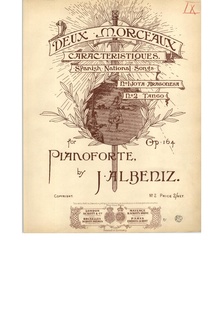Tango op.164, No. 2 (Albeniz)

The Tango op. 164, No. 2 by Isaac Albéniz is a seldom played piece compared to his well-known Tango in D , op. 165, No. 2, from the Suite España . The dance was published in 1889 together with an Jota Aragonesa by Schott , London in the album Deux morceaux caracteristiques pour pianoforte . The piece is not an Argentine tango , but a modeled tango andaluz . Albeniz dedicated this dance to a young woman: Souvenir amicale à Miss Nina de Lara.
Musical structure
The tango has the continuous rhythm of a gentle habanera and is written in the key of A minor . The composer provides an Allegretto ( cheerful, cheerful ) as the tempo , but does not specify a metronome number . Depending on the interpretation, the dance lasts between three and a half and five minutes. Albeniz uses 2/4 time , which runs through the entire piece (with the exception of the final cadence in 3/4 time). The tango is divided into three parts. The first part in A minor, which extends over 48 bars, is followed by the second in 46 bars in A major . The final section is again in A minor and ends after 50 bars with the one-bar cadenza in E major . The piece begins in the tone strength ( mezzoforte ), which weakens in a ( pianissimo ), becomes stronger again, also in the final cadence, but in the last bar again, in accordance with the melancholy character of the piece, ends very softly in pianissimo .
![]()
![]()
Interpretations
Tango No. 2 stands in the shadow of the much better known tango in D, which is often played. But the little melancholy-dreamy piece with a folkloric touch is always reinterpreted. In a historical recording from 1936, the pianist Ricardo Viñes plays the tango in a fast version. More the rhythm synkopisierend the Russian musician Oleg Boshnyakovich interpreted the piece. There are orchestral versions of the tango by Rodion Konstantinowitsch Shchedrin (with folkloric instrumentation) and the Russian conductor Arkadi Leytush.
Individual evidence and audio samples
- ^ Isaac Albéniz: Deux morceaux caracteristiques pour pianoforte , Schott London, 1889, second piece, Tango, p. 2
- ^ Isaac Albéniz: Deux morceaux caracteristiques ... , Schott London, 1889, second piece, Tango, p. 2 ff
- ↑ Ricardo Viñes
- ↑ Oleg Boshnyakovich
- ^ Admission to the symphony orchestra of the Belarusian State Academy
- ↑ Admission to the National Symphony Orchestra of Ukraine